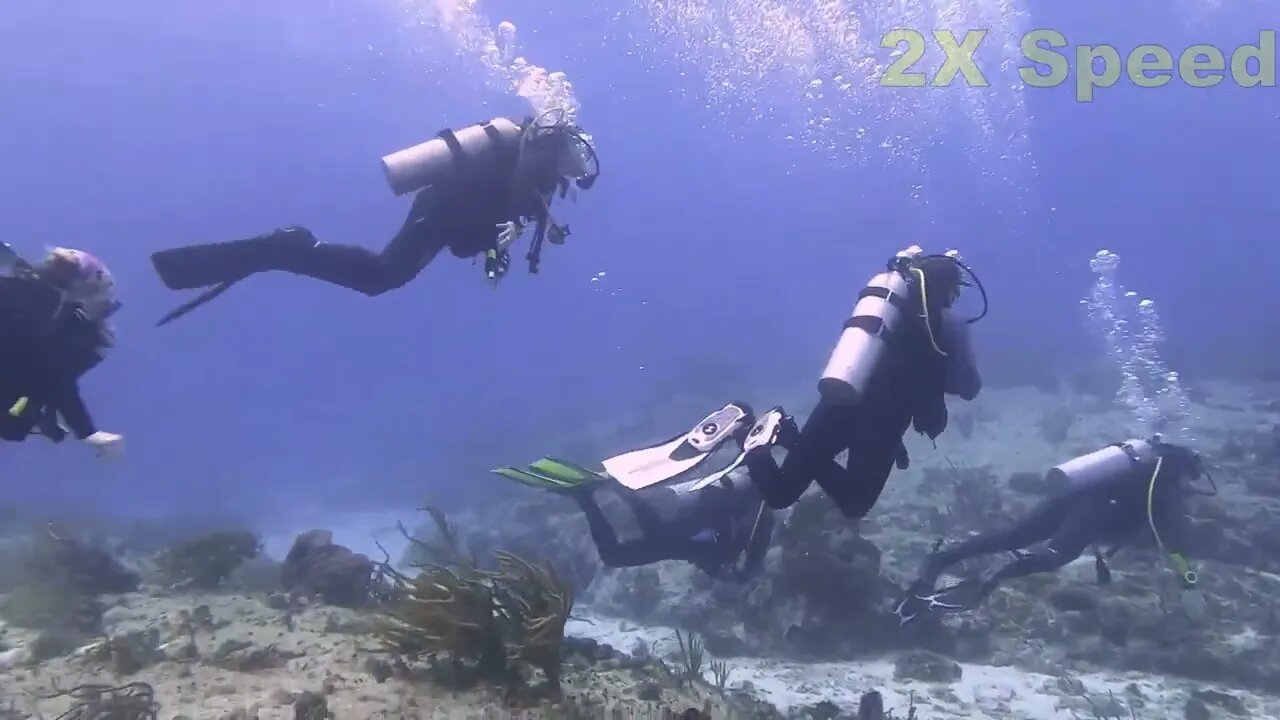Premium Only Content

Cozumel Dive 4
Welcome to my edited Diving video of San Clemente reef in Cozumel. In this video, I will show you some of the fish and other creatures that I encountered during my dive at one of the most beautiful sites in Cozumel. Some of the fish and other creatures that I saw include:
Banded Butterflyfish: These small fish have yellow and black stripes and a black spot on their rear dorsal fin.
Bi-Color Damselfish: These blue and yellow fish that live in shallow reefs and feed on algae.
Blue Chromis: These bright blue fish swim schools above the coral.
Blue Tang: These oval-shaped fish have blue bodies and yellow tails. They are also known as surgeonfish, because they have sharp spines on their sides.
Bluehead Wrasse - Initial Phase: These are fish that change color and shape as they grow. The initial phase is when they are young and have a blue head and a yellow body when older.
Caribbean Sharpnose Puffer: These small pufferfish have pointed noses and brown spots. They can inflate their bodies when threatened.
Feather Duster Worm: These tube-dwelling worms have a crown of feathery tentacles that they use to filter food from the water.
Foureye Butteryfly Fish: These white fish have black stripes and a black spot on their tail that looks like an eye to help them confuse predators.
French Angelfish: These large fish with black bodies and yellow edges. They are often seen in pairs or small groups.
Giant Anemone: These large anemones that have tentacles with stinging cells that they use to catch prey. They have a symbiotic relationship with some fish, such as clownfish, that live among their tentacles.
Gray Angelfish: These are similar to French Angelfish, but have a gray body and no yellow edges. They also have a black spot on their forehead.
Grooved Brain Coral: These hard corals have a brain-like appearance due to the grooves on their surface. They provide shelter and food for many reef animals.
Harlequin Bass: These colorful fish have a white body and black spots. They also have red, yellow, and blue markings on their fins and tail.
Honeycomb Cowfish: These box-shaped fish have hexagonal scales that form a honeycomb pattern. They also have horns above their eyes and can secrete a toxin when stressed.
Red Lionfish: These invasive fish have red, white, and black stripes and venomous spines. They have no natural predators in the Atlantic and can harm the native reef ecosystem.
Pipehorse: These relatives of seahorses have long, thin bodies and tube-like snouts. They camouflage themselves among the seagrass and coral.
Queen Parrotfish: These large parrotfish have blue-green bodies and pink lips. They use their beak-like teeth to scrape algae from the coral and produce sand as a byproduct.
Queen Triggerfish: These oval-shaped fish with blue, yellow, and purple markings. They have a spine on their back that they can lock in place to wedge themselves in crevices or deter predators.
Rock Beauty - Juvenile: Young Rock Beauty fish have a yellow body and a black spot on their tail. As they mature, they develop a black head and body with a yellow tail.
Sand Tilefish: These slender fish with blue-green bodies and yellow tails. They live in burrows under the sand and dart out to catch prey or flee from danger.
Scrawled Filefish: These flat fish have a brown body and blue lines. They have a retractable spine on their head and can change color to blend in with their surroundings.
Spotfin Butterflyfish: These white fish with black stripes and a black spot on their dorsal fin. They feed on coral polyps and other invertebrates.
Spotted Moray Eel: These are eels that have a brown body with white spots. They hide in holes and crevices and use their sharp teeth to catch fish and crustaceans.
Stoplight Parrotfish: These parrotfish that change color and sex during their life cycle. The initial phase is when they are female and have a red, brown, or green body. The terminal phase is when they are male and have a green body with a yellow spot on their head.
Yellow Jack: These are fast-swimming fish with a yellow body and a black stripe. They form large schools and hunt smaller fish.
White Speckled Hermit Crab: These are hermit crabs that have a white body with black spots. They live in empty shells that they carry around and swap when they grow.
Yellowline Arrow Crab: These crabs have a triangular body and long legs. They have yellow lines on their body and claws. They feed on small animals and debris.
Spotted Trunkfish: These box-shaped fish with black spots on a yellow background. They have a mouth at the end of a tube-like snout and can release a toxin from their skin when threatened.
And more
I hope you enjoy watching this video as much as I enjoyed making it. I’m not very good at picking music, so I apologize if the soundtrack is not to your liking. Please let me know what you think in the comments section below. Please like, share, and subscribe for more Scuba Diving videos. Thank you for watching!
-
 2:06:05
2:06:05
"What Is Money?" Show
2 days agoTrump Family Bitcoin Bet Will Trigger Nation-State FOMO w/ Matt Prusak (CEO American Bitcoin)
9.34K -
 1:04:36
1:04:36
Dialogue works
3 days ago $3.66 earnedMohammad Marandi: Iran Just Gave Israel a FINAL Warning…
16.3K6 -
 9:20
9:20
daniellesmithab
1 day ago3 Bad Laws
18.9K7 -
 9:22
9:22
MattMorseTV
18 hours ago $11.18 earnedINDIA just made a BIG MISTAKE.
62K57 -
 12:11
12:11
Nikko Ortiz
17 hours agoCrashout 6 Rumble
15.5K3 -
 22:35
22:35
GritsGG
17 hours agoThe KILO is BACK! The Best AR on Warzone FRIES!
24K1 -
 2:16:36
2:16:36
Side Scrollers Podcast
20 hours agoStreamer KICKED OUT of Renaissance Fair for Misgendering + Spiderman MELTDOWN | Side Scrollers Live
46.1K8 -
 12:29
12:29
The Pascal Show
1 day ago $2.18 earnedLOCKED IN A DUNGEON?! Parents Arrested After 5 Children Found In 'Dungeon' At Home
17.5K3 -
 LIVE
LIVE
Lofi Girl
2 years agoSynthwave Radio 🌌 - beats to chill/game to
333 watching -
 3:07:24
3:07:24
FreshandFit
12 hours agoPrivileged Nigerian Thinks Women Created Everything: HEATED DEBATE
155K93